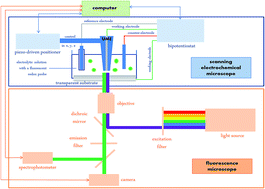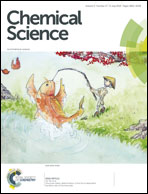Combined scanning electrochemical and fluorescence microscopies using a tetrazine as a single redox and luminescent (electrofluorochromic) probe†
Abstract
The possibility of using a single electroactive and luminescent molecule both as a redox mediator and as a fluorophore in an experiment combining in situ Scanning Electrochemical Microscopy (SECM) and epifluorescence microscopy was validated. The usual working modes of SECM, namely positive and negative feedback as well as generation–collection, were used and the fluorescence images, intensity and spectra were recorded for each configuration. The tip potential, tip–substrate distance and, in the case of a conducting substrate, the substrate potential are the parameters that are likely to control the fluorescence. It is shown that the tip can be used to switch on and off the luminescence and that the modulation amplitude maximum is sensitive to the nature of the substrate. Approach curves based on this fluorescence modulation amplitude can be obtained showing a higher sensitivity than the classical electrochemical ones.



 Please wait while we load your content...
Please wait while we load your content...